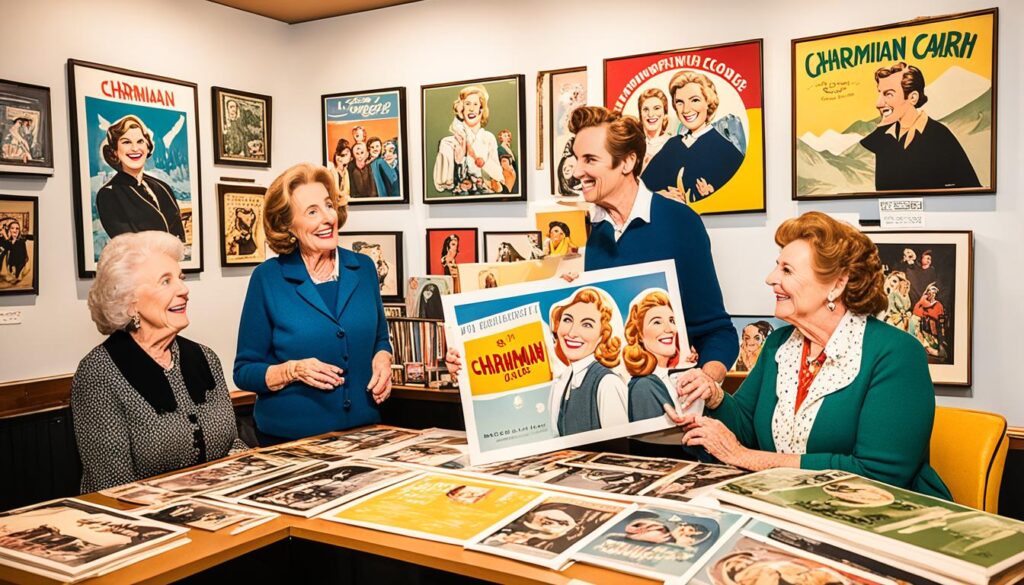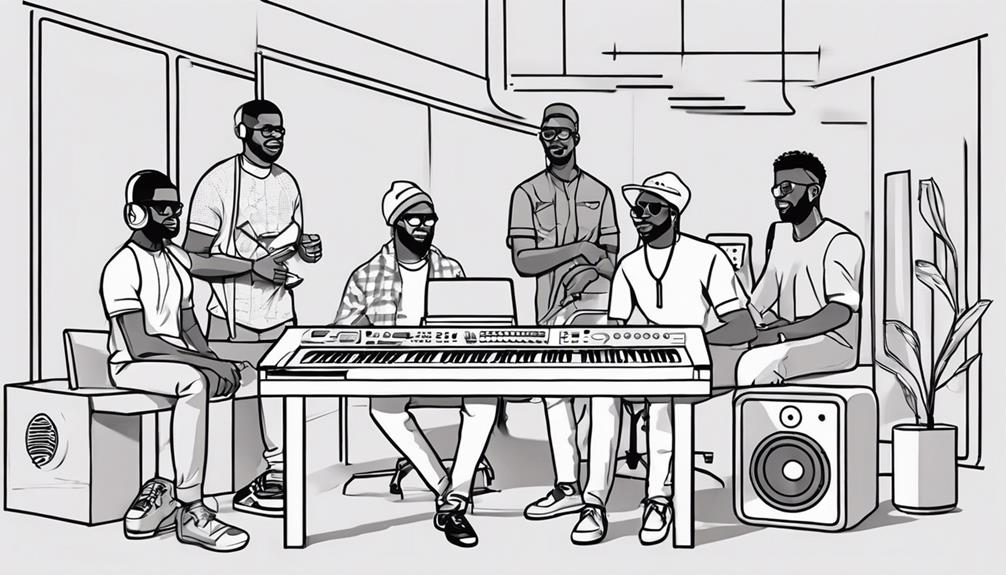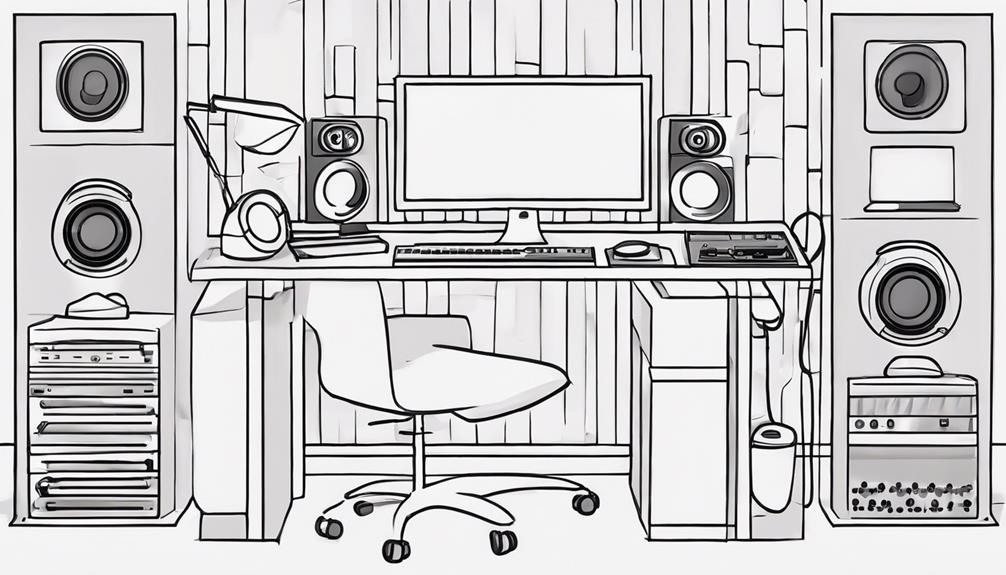Charmian Carr was just 21 when she became Liesl von Trapp in “The Sound of Music”1. Her youth and talent made her unforgettable in the film world.
As Liesl von Trapp, Carr won hearts globally and helped make the film a classic2. Thanks to her, “The Sound of Music” bagged five Oscars, including Best Picture1.
Carr left us at 73, after battling a rare dementia1. Her death was a big blow to her many fans.
Though best known for Liesl, Carr had another role in 1966’s “Evening Primrose” with Anthony Perkins1. Her acting journey was brief but impactful.
After acting, Carr wrote two books about her “Sound of Music” experience1. Her works, “Forever Liesl” and “Letters to Liesl,” let fans see behind the scenes.
Later, Carr became a successful interior designer1. She even worked for Michael Jackson, showing her wide range of skills.
Carr is remembered by her daughters, siblings, and grandchildren1. Her legacy in entertainment and her personal life remains powerful.
We will now look at Carr’s journey from Chicago to being Hollywood’s Liesl von Trapp2.
Key Takeaways:
- Charmian Carr was only 21 years old when she was cast as Liesl von Trapp in “The Sound of Music”1.
- “The Sound of Music” won five Oscars, including Best Picture1.
- Carr passed away at the age of 73 due to complications from dementia1.
- She authored two books, “Forever Liesl” and “Letters to Liesl,” about her experience in the movie1.
- Carr had a successful career as an interior designer, with clients including Michael Jackson1.
The Life and Career of Charmian Carr
Charmian Carr was born on December 27, 1942, in Chicago, Illinois. She was famed for her role as Liesl in “The Sound of Music.” Carr grew up in a family of performers in California, with a vaudeville actress mother and a musician father3.
At 21, Carr made her big break as Liesl in “The Sound of Music.”4 This role became the highlight of her career. Her performance won hearts globally and the film made $200 million worldwide4.
Following the movie’s success, Carr kept pursuing her love for acting. She starred in “Evening Primrose” in 1966 and appeared in a pilot with Van Johnson3.
In 1967, Carr chose to focus on her family life. She married Jay Brent, a dentist, and they had two daughters53. Around this time, she also founded her interior design firm, Charmian Carr Designs, in Encino, California3.
Carr always cherished her “The Sound of Music” days. She authored “Forever Liesl” and “Letters to Liesl” with Jean Strauss4. These books share her experiences and the movie’s impact on her life.
In 2010, Carr and her co-stars celebrated the film’s 45th anniversary on The Oprah Winfrey Show3. In 2014, she recorded “Edelweiss” with the von Trapps’ great-grandchildren, proving her lasting bond with the film’s music3.
Charmian Carr passed away on September 17, 2016, from frontotemporal dementia at age 7353. Her role as Liesl and her work in entertainment live on in the hearts of fans everywhere.
The Legacy of Liesl
Charmian Carr’s role as Liesl von Trapp in the 1965 film “The Sound of Music” made a lasting impression. Her performance captivated fans all over, making her a beloved actress6.
The gazebo scene where Liesl sings “Sixteen Going On Seventeen” is unforgettable. Carr and Daniel Truhitte’s chemistry made it a highlight of the film.
Carr loved “The Sound of Music” deeply. She connected with fans at sing-alongs and through her autobiography, “Forever Liesl.” Published in 2000, her book became a bestseller in the U.S., sharing insights and experiences7.
After leaving acting, Carr focused on interior design and wrote “Letters to Liesl.” This book includes fan memories and shows her bond with her audience. Her work keeps her connected to the movie’s lasting impact.
“The Sound of Music” remains popular, ensuring Carr’s legacy lives on. It’s available on DVD, TV, and online, reaching new fans. Memorabilia collectors add to its cultural importance6.
Charmian Carr’s portrayal of Liesl left a mark on film history and hearts worldwide. Her role brings joy and inspiration to many, remembered across generations.
Charmian Carr’s Personal Life and Family
Charmian Carr was best known as Liesl von Trapp in “The Sound of Music.” She was born in Chicago, Illinois, in 19428. Later, her family moved to the San Fernando Valley during her childhood9.
Though famous as Liesl, Carr lived a life away from the public eye. She leaves behind four siblings: Sharon, Darleen, Michael, and Brian9. She was also a mother to Jennifer and Emily, and a grandmother to four: Emma, Derek, William, and Tucker9.
Carr turned her passion for home into a new career in interior design. She started Charmian Carr Designs in Southern California9. She worked with stars like Michael Jackson and Ernest Lehman, writer of “The Sound of Music.”9
| Siblings | Children | Grandchildren |
|---|---|---|
| Sharon | Jennifer | Emma |
| Darleen | Emily | Derek |
| Michael | William | |
| Brian | Tucker |
For Carr, her family and personal life were everything. She was a successful actress, yet she cherished time with her loved ones more. Her legacy is marked by her iconic role and her deep bonds with family and the von Trapp children actors from “The Sound of Music.”9
Remembering Charmian Carr’s Impact
Charmian Carr’s passing deeply touched fans and those in the industry10. She shone as Liesl von Trapp in “The Sound of Music,” winning over audiences with her charm. Her influence went beyond the film, guiding co-stars on and off the set11.
After her death, many paid tribute to Carr. Ted Chapin from the Rodgers and Hammerstein organization praised her role in “The Sound of Music”10. He noted how Carr’s Liesl connected with people, making the film even more beloved10.
Celebrities and groups like 20th Century Fox and Seth MacFarlane honored Carr’s talent and her effect on them10. Her dedication to acting left a lasting mark on viewers10.
The “Sound of Music” community felt Carr’s loss profoundly. Fans worldwide shared how Liesl inspired them10. Carr’s role brought joy and hope, creating a legacy that continues to inspire10.
Carr was more than a talented actress. Her kindness and warmth touched many beyond her roles10. Known for her connection with fans, Carr’s spirit made a lasting impression10.
Though we’ve lost Charmian Carr, her impact endures in our hearts and memories. She remains the beloved Liesl von Trapp, leaving a lasting imprint on cinema10.

References:
- Reference 1
- Reference 2
- Reference 3
Carr’s Battle with Dementia
Charmian Carr faced dementia in her later years. This condition contributed to her death at 7312. The type of dementia she fought was not made public. This painful truth reminds us of the disease’s harsh effects12. Carr’s family chose to keep her struggle private. They honor her memory and her role in the entertainment world12.
Dementia leads to a drop in mental skills. It affects memory, thought, and how one acts. It greatly impacts the person and their family. Carr’s fight with this illness underscores the need to spread awareness and support research12.
Charmian Carr, as Liesl Von Trapp in The Sound of Music12, brought happiness to many. Her talent and vibrant spirit won over fans everywhere. Her contribution will influence many future generations12.

The above image shows dementia’s effects on people and their families12. It reminds us to support efforts in research for better treatments. Helping those hit by this condition is crucial12.
| Carr’s Battle with Dementia | |
|---|---|
| Age at the time of passing | 73 |
| Cause of death | Complications from a rare form of dementia |
Despite her fight with dementia, Carr’s role as Liesl Von Trapp remains unforgettable12. Her spirit and legendary act still charm watchers worldwide12.
Charmian Carr’s Contributions Beyond Acting
After she stopped acting, Charmian Carr tried new and creative things. She succeeded in various areas.
Carr started a design business that did really well. She had a natural skill for design and paid great attention to details. These qualities made her well-known in her field.
Besides designing, Charmian Carr wrote two books. They give a close-up view of her time in “The Sound of Music.” Her book, “Forever Liesl,” talks about her role as Liesl von Trapp. It shows how the film left a big mark on her life. She shared stories and secrets from behind the scenes, drawing readers in. Nearly all of her autobiography focuses on “The Sound of Music.”13 Also, in “Letters to Liesl,” Carr wrote letters to her character. She explored how the role of Liesl changed her life.
Moreover, Carr’s design business linked her with music star Michael Jackson. He admired her creative talent. Their work together showed the respect she earned in the industry13.
Carr did more than act. Her design and writing helped her touch many lives. She left a mark that goes beyond movies.
The Sound of Music Fan Community
The Sound of Music has won hearts for years with its unforgettable songs, touching story, and memorable characters. It draws fans from every age, creating a strong, loving fanbase. Many adore Charmian Carr, known as Liesl von Trapp, for her wonderful acting and kind nature.
Charmian Carr’s role as Liesl made a big impact on fans. She often met them at events. These include The Sound of Music sing-alongs where fans dress up and enjoy the movie together5.
As Liesl, Carr was a standout, capturing hearts worldwide. The film is a favorite for many, winning a People’s Choice Award for most popular movie. Its success shows how much it means to people14.
The Sound of Music hit theaters for nearly five years and is a top-selling video. Carr was 21 when she played Liesl, contributing to the film’s triumph141. She also showed dedication by sticking to a strict school schedule during filming14.
Although Carr stopped acting to raise her family, she stayed close to the fan community. She touched lives with her role and received touching fan mail. Carr became more than an actress to her fans14.
Charmian Carr’s warm connections with fans and her memoir, “Forever Liesl,” keep her memory alive. She also ran a successful interior design business. Her creativity and business sense impressed many, including Michael Jackson514.
Charmian Carr will always be remembered by The Sound of Music community. Her portrayal of Liesl and her bond with fans have made a lasting impression514.

Carr’s Singing and Dancing in The Sound of Music
Charmian Carr, known for her role as Liesl von Trapp, charmed everyone in “The Sound of Music” in 1965. Her incredible singing and dancing left a mark on all who watched. She brought something special to the screen.
Her performance of “Sixteen Going On Seventeen” was unforgettable. Singing with Daniel Truhitte, who played Rolfe, they created a magical moment. It was a scene that won over hearts around the world.
Carr faced a big hurdle during casting because of her stunning blue eyes. At that time, they couldn’t change her eye color with contact lenses. But, they used lighting tricks to let her beauty shine, helping her embody Liesl wonderfully.
Her dancing in the film showed her range as an actress. She did everything from running and jumping to complex dances. Carr’s hard work made Liesl’s character come alive, winning the audience’s hearts with her grace.
Carr’s role as the eldest Von Trapp daughter was powerful. She became a key part of “The Sound of Music” and its lasting legacy. Her impact on fans was immense, making her role unforgettable.

Carr’s Post-Acting Career and Retirement
Charmian Carr said goodbye to acting and started a new part of her life. She focused on her family and followed her love for interior design. She opened Charmian Carr Design , her very own interior design business.
She didn’t stop there. Carr also began writing, sharing her stories in two books. Her first book, “Forever Liesl,” came out in 2000. It’s a touching look at her experiences filming “The Sound of Music” . Encouraged by her readers, she wrote “Letters to Liesl” in 2001. This second book allowed her to go deeper into her journey and connect with her fans .
After acting, Carr took the chance to be creative in new ways. She made a mark in the design world and in the hearts of those who loved her as Liesl in “The Sound of Music.”
Carr relished in her accomplishments with her beloved family by her side. She leaves behind four siblings, two kids, and four grandkids .
The Sound of Music’s Enduring Popularity
Since its release in 1965, The Sound of Music has won hearts globally. Its timeless music, touching story, and unforgettable performances make it a cinematic treasure.
Charmian Carr’s performance as Liesl is a big reason for the film’s magic. She brings charm and depth, making her character stick with audiences long after.
The movie wasn’t just loved; it was a box office hit, earning $163 million in the US alone15. Its soundtrack ruled the UK charts for 70 weeks, standing with iconic bands16.

Events and tributes show how much we adore The Sound of Music. In 2006, a contest sought a new star for its West End show16. London’s Prince Charles Cinema’s sing-along events prove its charm hasn’t faded16.
Even stars like Lady Gaga honor it. She performed a medley at the Oscars to mark its 50th year16. Christopher Plummer praised its timeless appeal, despite his funny nickname for it16.
Its magic comes from amazing music, touching stories, and standout moments like Carr’s Liesl. Its massive earnings, hit soundtrack, and cultural footprint show why it remains dearly loved.
Conclusion
Charmian Carr is remembered lovingly for her role as Liesl in The Sound of Music. Her performance won the hearts of fans globally. She played the eldest von Trapp daughter and made a lasting impression.
Charmian earned a spot in movie history with her talent and hard work. Although she was in just one film, The Sound of Music, that movie earned five Oscars and made $200 million worldwide4. At 21, she perfectly portrayed Liesl von Trapp with her beautiful voice and acting skills.
After her acting career, Charmian had a rich life. She was a loving mother to her daughters, Jenifer and Emily. She then became a successful interior designer with her own firm, Charmian Carr Designs17. She worked with many clients, including Michael Jackson.
Charmian Carr’s impact goes beyond her acting. She connected with fans through her books, Forever Liesl and Letters to Liesl, with Jean Strauss4. Her stories included her crush on Christopher Plummer. Fans have shared memories and appreciation for years18. Charmian’s legacy lives on in her portrayal of Liesl and the happiness she brought to many.
FAQ
Who was Charmian Carr?
What was Charmian Carr’s role in The Sound of Music?
What is The Sound of Music?
When did Charmian Carr pass away?
What books did Charmian Carr write?
Who did Charmian Carr leave behind?
What was Charmian Carr’s battle with dementia like?
What was Charmian Carr’s post-acting career?
Did Charmian Carr interact with fans?
What is Charmian Carr’s legacy?
How did Charmian Carr contribute to The Sound of Music?
Why is The Sound of Music still popular today?
What Impact did Charmian Carr’s Role in Sound of Music Have on Choosing a Music School?
Charmian Carr’s iconic role as Liesl Von Trapp in the Sound of Music influenced many to pursue music education. Her portrayal of a talented, passionate young woman highlighted essential music school factors like performance skills, musicality, and dedication, inspiring aspiring musicians to seek these qualities in their own education.
Source Links
- https://www.latimes.com/local/obituaries/la-me-charmian-carr-20160918-snap-story.html – ‘Sound of Music’ actress Charmian Carr, who played Liesl von Trapp, dies at 73
- https://www.cbsnews.com/baltimore/news/sound-of-music-actress-liesl-charmian-carr-dies-at-73/ – ‘Sound of Music’ Actress ‘Liesl’ Charmian Carr Dies at 73
- https://en.wikipedia.org/wiki/Charmian_Carr – Charmian Carr
- https://www.theguardian.com/film/2016/sep/20/charmian-carr-obituary – Charmian Carr obituary
- https://www.imdb.com/name/nm0139642/ – Charmian Carr | Actress, Soundtrack
- https://dollsmagazine.com/so-long-farewell-to-charmian-carr-forever-known-as-liesl-von-trapp/ – “So Long, Farewell” to Charmian Carr, forever known as Liesl von Trapp | DOLLS magazine
- https://www.independent.ie/entertainment/movies/movie-news/sound-of-music-star-charmian-carr-suffered-a-bout-of-depression-and-developed-two-phobias/35062406.html – Sound of Music star Charmian Carr suffered a bout of depression and developed two phobias
- https://www.abc.net.au/news/2016-09-19/the-sound-of-music-charmian-carr-liesl-von-trapp-dies/7856706 – Charmian Carr, actress best known as The Sound of Music’s Liesl, dies
- https://chicago.suntimes.com/2016/9/19/18364974/charmian-carr-eldest-daughter-in-sound-of-music-dies-at-73 – Charmian Carr, eldest daughter in ‘Sound of Music,’ dies at 73
- https://pagesix.com/2016/09/19/sound-of-music-actress-charmian-carr-dies-at-73/ – ‘Sound of Music’ actress Charmian Carr dies at 73
- https://www.goodreads.com/book/show/105609.Forever_Liesl – Forever Liesl
- https://www.straitstimes.com/lifestyle/entertainment/fans-mourn-death-of-charmian-carr-who-played-liesl-in-sound-of-music – Fans mourn death of Charmian Carr, who played Liesl in Sound Of Music
- https://www.theguardian.com/film/2000/nov/12/film – Charmian ‘Liesl’ Carr has written a book on The Sound of Music
- http://www.cnn.com/COMMUNITY/transcripts/2000/2/carr/ – CNN – Chatpage – Books
- https://www.britannica.com/topic/The-Sound-of-Music-film-by-Wise – The Sound of Music | Plot, Cast, Awards, & Facts
- https://www.bbc.com/news/uk-37405216 – Why fans are still singing along to the Sound of Music
- https://fox59.com/news/entertainment/charmian-carr-the-actress-who-played-liesl-in-the-sound-of-music-dies/ – Charmian Carr, the actress who played Liesl in ‘The Sound of Music,’ dies
- https://obits.oregonlive.com/us/obituaries/oregon/name/charmian-carr-obituary?pid=181453141 – Charmian Carr Obituary (1942 – 2016) – Connellsville, PA – The Oregonian










